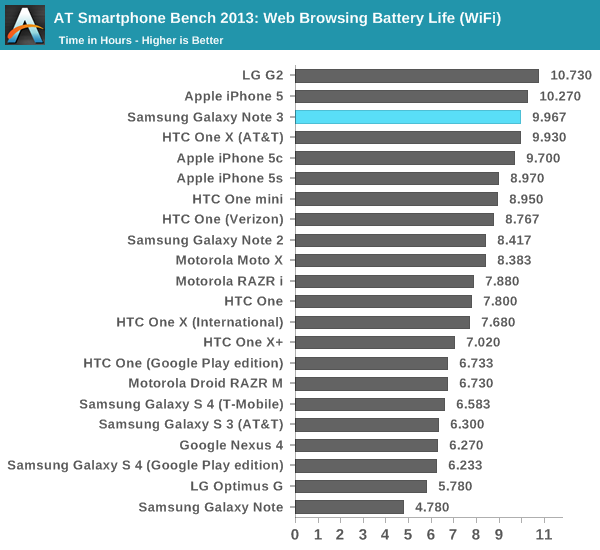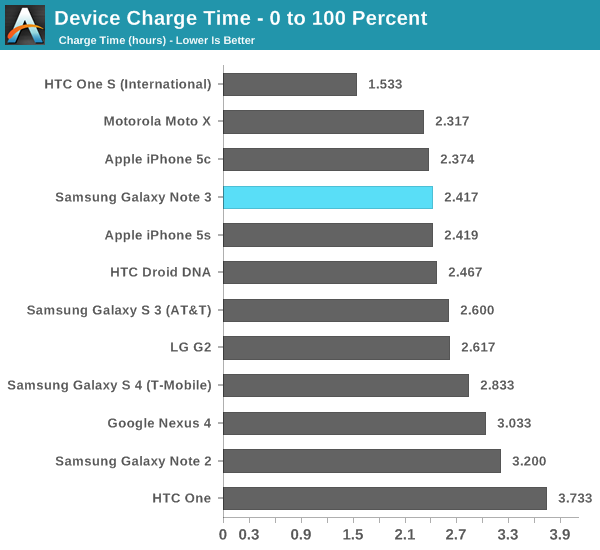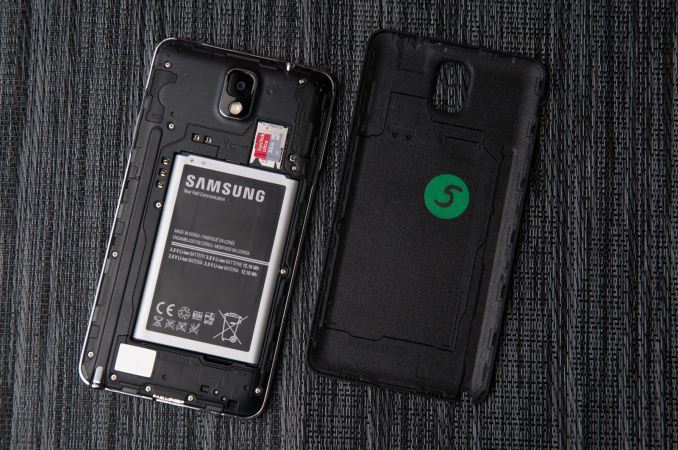Samsung Galaxy Note 3 Review
by Brian Klug on October 1, 2013 9:00 AM EST- Posted in
- Smartphones
- Samsung
- Mobile
- Android 4.3
- galaxy note 3
Battery Life
Battery life remains probably the single largest differentiator for devices lately, and of huge concern to enthusiasts and normal shoppers alike. We’ve already caught a glimpse of how well 8974 fares from a power perspective inside the LG G2, a device that posted some seriously impressive battery numbers. The Note 3 we’re looking at is also 8974 based since it’s a T-Mobile model, and thus we expect the same kind of battery life.
With this generation of Note, battery gets even larger. The Note started with a then quite large 9.25 watt hour battery, then Note 2 moved to 11.78 watt hours, and Note 3 now moves to a very large 12.16 watt hour battery with of course the newest 3.8V chemistry and all that comes along with it. Display size goes up, but those power gains are offset in other places.
After we talked about the panel self refresh features in the G2 a few people reached out and let me know that this feature has been shipping for a while in some phones, and it’s easy to check for. If we look under the display subsystem we can see that the same MIPI_CMD_PANEL type 9 is used, which refers to this type of interface.
Qualcomm HWC state: MDPVersion=500 DisplayPanel=9
define MIPI_CMD_PANEL ‘9’
Our battery life tests are unchanged and consist of a set of popular webpages that are loaded on a schedule with the display set to exactly 200 nits and repeated until the battery runs out and the device dies on both WiFi and cellular data connections. In this case that means T-Mobile LTE which is 10 MHz FDD in my market, I haven’t had a chance to run the Note 3 on HSPA+ yet, or complete the call test (which is starting to get ridiculous, and probably breaks 24 hours in the case of the Note 3).

On LTE the Note 3 does very well, coming just shy of the pack of iPhones, at just over 8 hours. Interestingly enough it’s just north of the G2s as well, which do have a smaller battery but also smaller display. The Note 3 also is the first device to ship with Qualcomm’s QFE1100 envelope tracker solution from the RF360 front end portfolio, which lowers power consumption by up to 20 percent and heat dissipation by up to 30 percent by allowing the power amplifiers to follow the desired output waveform. There’s more on that later in the cellular section.

On WiFi the Note 3 does better by 22 percent, but not the kind of huge jump I’m used to seeing between cellular and WiFi testing. This tells me the Note 3 battery life is really gated by the display, which is almost always the largest consumer of power in a device. That said the Note 3 does very well all things considered, especially in comparison to the APQ8064 (Fusion 3) phones which came before it, like SGS4. New silicon and new process inside MSM8974 definitely helps move battery life forward here with the race to sleep game.
Charging is an interesting story on the Note 3, but primarily because of what doesn’t change. The Note 3 continues to use Samsung’s tablet charging specification and charger, which has 2 amps of maximum output. The Note 3 draws 2 amps over a considerable amount of the charging curve, like other Samsung devices (in the linear part of the charge curve). USB 3.0 doesn’t change things up here quite yet with the new supported charge voltages that are coming eventually with the power delivery specification.

The Note 3 does charge faster overall compared to the SGS4 however thanks in part to the new PMIC (PM8941) which is part of the overall 8974 platform story.











302 Comments
View All Comments
Puddlejumper - Tuesday, October 1, 2013 - link
I too am very disappointed with AnandTech. To know that the benchmarks are "fudged" but then to continue on and show many benchmarks and draw conclusions on the phones performance just rewards the manufactures for cheating. Samsung got what it wanted. Pity the poor manufacture that played it straight. They just got taken.Congratulations to Ars Technica for playing it straight. Too bad AnandTech willingly chose to play along.
ddriver - Tuesday, October 1, 2013 - link
Ensuring the CPU runs at its peak stock frequency is not cheating. It is just an effort to get realistic performance figures. The problem is that those tests are really short, so the time it takes for the chip to ramp up its frequency to react to an intense workload is big enough to give unrealistic results with such short tests (most of which less than half a second).In an actual, real world performance intensive scenario the chip would continuously work at its peak, so the hit won't be anywhere as significant.
It is the anti-samsung PR from its competitors that is blowing this out of proportion in an ill attempt to hamper a product that pretty much annihilates everything else on the market.
Puddlejumper - Tuesday, October 1, 2013 - link
Really. Did you read Ars Technica's review? It only runs that way for specific "named" benchmarks. It doesn't run that way for any other program. No one who buys the phone will get that performance (for good reasons, battery life, thermal issues) running any other program. How does that help me compare the performance of phones? How does that help me judge the different implementations of the same of different processors? What it does is make all the benchmarks AnandTech ran pretty meaningless.What is really disappointing to me is AnandaTech knew this was going on and after blowing it off with a sentence went ahead and presented all the fake benchmarks anyway. As a long time reader I expected much better from them.
ScorpionRaY - Tuesday, October 1, 2013 - link
Benchmarking is the way to compare peak performance (whole potential). On your PC, the CPUwill rarely run at 100% but it's still a good indicator when your CPU runs at 100%
Puddlejumper - Tuesday, October 1, 2013 - link
Very different. Phones (and Tablets) have much more stringent thermal and battery limitations than PC's. The point here is that the behavior of the Note's processor is never seen except in the benchmarks.ScorpionRaY - Wednesday, October 2, 2013 - link
Unless there is evidence that the smartphone would break at that frequency. Battery-wise, it may lose but performance is another thing.Deelron - Wednesday, October 2, 2013 - link
No, it's a way to compare whatever you want to benchmark, otherwise why would there even be a benchmark suite that's designed to measure real world usage? Whether it does so or not is debatable, but if that's the goal it surely isn't trying to measure just pure peak performance.ScorpionRaY - Wednesday, October 2, 2013 - link
There are suites to benchmark daily use. But the scores mentioned here are purely about (peak) performance.nerd1 - Tuesday, October 1, 2013 - link
Can you double check the USB connection? I've seen many evidences that using USB3 cable boosted the transfer speed almost 2x.shorty lickens - Tuesday, October 1, 2013 - link
Jesus Christ! My note 2 looks like a little bitch.